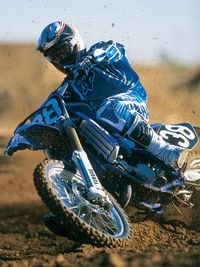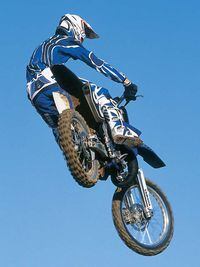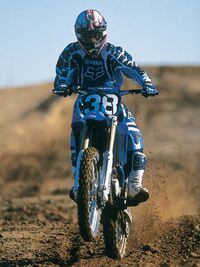Yamaha is fierce when it comes to keeping blue in the black. Although its four-strokes have attracted public interest over the last few years, its two-stroke line is as good as ever. So when Yamaha wanted to hog a chunk of the limelight, it did so by unleashing the first test bike for 2004--the YZ125. With the onslaught of new 250cc four-strokes entering the market for '04, there has been some question as to the fate of mixed-fuel burners. Yamaha assured us it has no plans to abolish two-strokes anytime soon. It could very well continue to develop the current model and extend its life for years to come through engine, suspension and bodywork transformations.The new, improved YZ125 looks similar to the '03 iteration--but don't be fooled, it is more than simply BNG (Bold New Graphics). A closer look reveals Yamaha took a magnifying glass to the bike and then targeted specific areas for improvement. The most noteworthy has to be the new Kayaba 48mm fork. The entire line of YZs adopted the new front legs, which abolish the long-standing elastomer bottoming system for a newly designed hydraulic configuration. A host of other changes spruce up the power delivery, including altered port timing, improved carburetion, a hotter spark with a shorter duration and a slightly modified exhaust and muffler. Incidental changes consisted of a nonslip seat cover, titanium footpegs and redesigned triple clamps, among others.Changes aside, the true testament to any bike is feedback from track testing. After a little setup, we hammered some laps to discover Yamaha once again hit the mark. The motor was impressive--it brought back memories of a modified '01 YZ125. There is enough meat in the mid to feed a family of five. The '04s are renewed with a compelling midrange hit that is quite robust, to say the least. To our surprise, the power kept pulling and extended into a very usable overrev similar to the '03 YZ125. On the flip side, the delivery down low can be a little sluggish at times. When the power falls off, it takes some clutch abuse and patience before the mid starts to develop. For our pro-level testers it never was an issue, though for intermediate or below pilots it was, especially while riding in sand or heavy soil. To remedy the problem, we went from the stock 49-tooth sprocket to a 50. The closer ratio improved the gear spacing, making it easier to keep it on the pipe while exiting corners. All in all, the bike is fast and very competitive; it just lacks an easy-to-manage transition from the lower range before it takes off like a rocket and revs to the upper ranks. As for how this two-stroke will fare against the new four-strokes from Honda, Kawasaki and Suzuki, we will just have to wait and see.Due to the hot-weather conditions, we swapped the stock needle for a richer 6CHY6-80 with the clip in the third position. There had been a little pop and a slight hesitation in the mid, but the needle cleared it up. The switch had a lot to do with the temperature, and we don't necessarily recommend the substitution unless you experience similar feedback.With the engine ready to rock, we turned to the suspension and handling of the bike. After a few laps, we all came back smiling because the fork doesn't bottom. If you have ridden or own a recent YZ model, you have most definitely felt that infamous bottoming thud. The 2mm-larger fork tubes combined with the new hydraulic bottoming system makes a huge difference. According to Yamaha, its engineers were able to improve the action of the fork without having to run stiff settings to avoid harsh bottoming.The front and rear are very balanced, and most of our test riders made very few changes to the clickers from the stock settings. The sag was set at 100mm, which accommodated testers ranging from 165 to 185 pounds. The fork is so plush it's almost scary. The YZ has always been a high scorer in the handling department, and it is once again. The bike tracked through the gnarliest sections without a whimper. A few novice testers had some trouble keeping the bike settled in corners and noted the YZ tended to ride high in ruts. Contrarily, the pro testers felt the bike carved turns with ease, like a hot knife through butter.The ergonomics are well thought out, and all riders were keen on the new nonslip seat cover. The brakes are very powerful and equal anything currently in the class.With the bikes of today leaving the showroom so competitive, aftermarket companies must scramble to build a better product. Yamaha is all over trying to stay ahead of the game, and it has yet to drop the ball with its eighth-liter two-stroke. From national-level riders to local amateurs, all commented that the '04 YZ125 has some of the the best stock suspension they have ever ridden and the engine could be raced in stock form. Four-strokes may eventually take over, but as for now, the two-stroke is here to stay--at least for 2004.Opinions
The bottom-end of the power range felt a bit weak for my liking, though the extremely loamy track played havoc on the Y-zinger. However, one tooth larger in the sprocket made life grand. The new YZ motor has more midrange than any other 125 I have ridden. It revs out like last year's bike but seems a bit harder to keep on the pipe. The fork is awesome; I tried unbolting a set to take home, but the Yamaha guys didn't find that so funny. The suspension and handling on the Yamaha are impressive. The new, larger fork gave me a feeling of confidence when trying jumps for the first time, mainly because bottoming is no longer an issue. The brakes are as terrific as they have been in the past. The rider compartment feels very comfortable and is roomy enough for my height and riding style. With a few minor changes in jetting and gearing this bike would be a very potent race weapon.
Brad Daugherty/6'0"/165 lb/IntermediateThe 2004 YZ125 wasn't all that different from the '03 model. The only big changes that I felt were from the bottom- and top-end performance and the fork. The motor still has a strong pull down low, but it is not quite as good as the '03 version's; the midrange is really wide and can be shifted early. The '04 also seems to pull longer than the '03. So it is a give-and-take. The '04 YZ125 is more suitable for faster riders. The bike is so much better with the 48mm fork on it. It can handle slap-down landings without that dreaded clank Yamaha owners are used to. The bike also soaks up small chop a bit better. The shock is good but may be a tad too soft for my liking; a heavier spring will do. The ergos remain good and the graphics still look wrecked after a couple of rides. All in all, the 2004 edition is a little better.
Kris Keefer/5'11"/170 lb/ProThe '04 YZ125 feels like a full-on race bike right out of the crate, with the exception of the missile on the bike that all manufacturers call silencers. This could possibly be the best stock 125 I have ever ridden. With a few carburetor adjustments and a 50-tooth rear sprocket to replace the 49, the bike pulled hard and strong throughout the powerband. The new Kayaba 48mm fork that replaced the old 46mm is icing on the cake. The suspension couldn't be better. If I had to race the bike, I would leave the valving and clickers bone stock, that's how good they are. The new YZ will be a threat in this year's shootout.
Levi Reid/5'10"/160 lb/Pro



/cloudfront-us-east-1.images.arcpublishing.com/octane/KQUVDTNB6VF53CRDNN47BE3VUA.jpg)
/cloudfront-us-east-1.images.arcpublishing.com/octane/3T32INAZQRGPXOGGA36NQJDSSM.jpg)
/cloudfront-us-east-1.images.arcpublishing.com/octane/EPLS5PBKXBHNXK7S5O7G4ND3YQ.jpg)
/cloudfront-us-east-1.images.arcpublishing.com/octane/MNGOZAGZFZBH5DPFV7NOPF5S3Y.jpg)
/cloudfront-us-east-1.images.arcpublishing.com/octane/VGJWIIFM2VBCXG34KRQ37GCP7U.jpg)
/cloudfront-us-east-1.images.arcpublishing.com/octane/2ZU3HXRPMZESJF7HDLZJV7FHEY.jpg)
/cloudfront-us-east-1.images.arcpublishing.com/octane/VVFWQBZEIZDVJHZIW5ISKWKOZU.jpg)
/cloudfront-us-east-1.images.arcpublishing.com/octane/7T7FZXHIIBDX7AOBD5S3IICUJI.jpg)
/cloudfront-us-east-1.images.arcpublishing.com/octane/T3Y7A52TXBEBJNEPGOQSVPQSPU.jpg)
/cloudfront-us-east-1.images.arcpublishing.com/octane/KY33U3WBTNFIBJFMTEF2SM7BOQ.jpg)
/cloudfront-us-east-1.images.arcpublishing.com/octane/JNPS5MGVXJC7BARVMARYQIQHXE.jpg)
/cloudfront-us-east-1.images.arcpublishing.com/octane/63N2P6SYAZDURJDO5KARQYX2J4.jpg)
/cloudfront-us-east-1.images.arcpublishing.com/octane/C72WX35SXFETTO5OVA2RWT523I.jpg)
/cloudfront-us-east-1.images.arcpublishing.com/octane/F3ER37EV2RGY5CRYFNTWE3JSF4.jpg)
/cloudfront-us-east-1.images.arcpublishing.com/octane/L65QCUR32RH2NKCUHXYHHAPDFI.jpg)
/cloudfront-us-east-1.images.arcpublishing.com/octane/VSK246VVRRDMBNQU7B2NTNY6AE.jpg)
/cloudfront-us-east-1.images.arcpublishing.com/octane/CG64RRFAYRENNAP2AA22T2LSJY.jpg)
/cloudfront-us-east-1.images.arcpublishing.com/octane/IKZSRLBWMRDORMORBXSISL4D6M.jpg)
/cloudfront-us-east-1.images.arcpublishing.com/octane/BJLVRPJSDFC3ZLPMW3LYYHMPZE.jpg)
/cloudfront-us-east-1.images.arcpublishing.com/octane/RQW2RFU4MJDYRPVFJNW362SEXU.jpg)
/cloudfront-us-east-1.images.arcpublishing.com/octane/CGQDU7HEEBBWBLF6SMXCJIW7DI.jpg)
/cloudfront-us-east-1.images.arcpublishing.com/octane/B35XXACE4ZGU5BWSEMEFUL6SN4.jpg)
/cloudfront-us-east-1.images.arcpublishing.com/octane/TDSGY4VSSRC4LP6PYXP62U236Y.jpg)
/cloudfront-us-east-1.images.arcpublishing.com/octane/4YWNAG64EZF63AQI3VL7ANERSY.jpg)